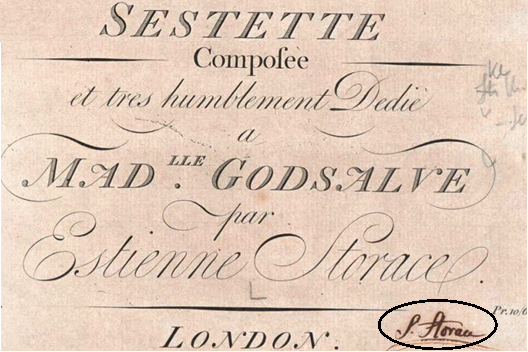Presents
Stephen Storace
Piano Sextet in G Major, Op.2 No.3 for Piano, String Quartet & Flute
 Stephen
Storace (1762-1796) was born London of an English mother and Italian father who
taught him violin. The boy became a prodigy on that instrument. His father sent
him to the Naples Conservatory for further studies. After returning to England,
he then traveled to Vienna to be with his sister Nancy, who was making a name
for herself as an opera singer. Storace remained in Vienna for several years
becoming a very popular opera composer and also becoming a good friend of
Mozart. Though he concentrated on opera, apparently he did not entirely ignore
chamber music. According to contemporary reports, he wrote a string quartet (now
lost) which was performed by four famous players--Dittersdorf on first violin,
Haydn on second, Mozart on Viola, and Vanhal on cello. Eventually, Storace
returned to London, where once again he concentrated on opera with considerable
success.
Stephen
Storace (1762-1796) was born London of an English mother and Italian father who
taught him violin. The boy became a prodigy on that instrument. His father sent
him to the Naples Conservatory for further studies. After returning to England,
he then traveled to Vienna to be with his sister Nancy, who was making a name
for herself as an opera singer. Storace remained in Vienna for several years
becoming a very popular opera composer and also becoming a good friend of
Mozart. Though he concentrated on opera, apparently he did not entirely ignore
chamber music. According to contemporary reports, he wrote a string quartet (now
lost) which was performed by four famous players--Dittersdorf on first violin,
Haydn on second, Mozart on Viola, and Vanhal on cello. Eventually, Storace
returned to London, where once again he concentrated on opera with considerable
success.
Storace paid a London printer (name unknown) to publish three chamber music works sometime between 1788 and 1791. There were two piano quintets and the Piano Sextet in G Major. He called the works his opus 2 and signed each copy before delivering them to various London music shops to be sold. The works were dedicated to one Miss Gonsalve, whom we were unable to identify. The Gonsalve family were from the gentry class and most likely Miss Gonsalve may have been an amateur pianist as the piano parts would certainly be manageable by an accomplished amateur pianist. In four movements, the work opens with a delicate Adagio con espressione. The Sextet shows a familiarity with the early Vienna classical style of the sort Haydn and Mozart were using in the 1770s. The second movement is marked Allegro con spirito, though the themes and tempi are genial, relaxed and somewhat stately. The third movement consists of two rather subdued minuets. The first is in the style of a slow French minuet. The flute part, in its lower register, almost gives the feel of a clarinet. The second minuet continues much in the same vein with themes that are closely related to the first. The finale, Fantasia, andante con moto, is actually a theme and set of variations in which the piano gives the first part alone, with other voices responding to the piano.
This is not only an historically interesting work because there are few if any English works of this type from this era. But it is also worth while because Storace treats the flute more or less as he does the other string parts. A concert performance will certainly interest audiences, but the work can definitely be recommended to amateur ensembles. We have reprinted a clean and readable copy of the original edition. The picture above shows the title page which was signed by Storace.
Parts: $24.95